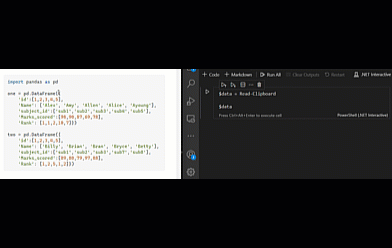
- #Powershell copy paste text clipboard how to
- #Powershell copy paste text clipboard install
- #Powershell copy paste text clipboard code
- #Powershell copy paste text clipboard windows
#Powershell copy paste text clipboard windows
Note that you can run powershell –sta –command Copy-Console.ps1 not only from Windows PowerShell console, but also from conventional CMD console. I’ve simply run the script and pasted the results in the blog post editor. The results of the script execution can be seen above. You can now paste it to any application that supports text, HTML or RTF pasting. The console screen has been copied to system clipboard. PS E:\MyScripts> powershell -noprofile -sta -command e:\myscripts\Copy-Console.ps1 Powershell -noprofile -sta -command d:\myscripts\Copy-Console.ps1 Start Windows Powershell with -STA switch, or rerun the script using powershell -sta -command. Windows PowerShell V2 (Community Technology Preview - Features Subject to Change)Ĭopyright (C) 2008 Microsoft Corporation. To run the script start Windows PowerShell console in STA mode or run the script using the powershell –sta –command line.
#Powershell copy paste text clipboard install
To use this script you need to install PowerShell V2 CTP3 on your machine.
#Powershell copy paste text clipboard code
Then, we place the results into system clipboard as shown in a code snippet above. In the attached script we are reusing the code from Capture console screen and Colorized capture of console screen in HTML and RTF to capture console screen buffer and transform it to three core text formats (Unicode Text, HTML and RTF). To work around this limitation in Windows PowerShell console you need to start Windows PowerShell console with -sta switch, which is available in CTP3 release of Windows PowerShell V2. Windows Powershell ISE runs in STA by default, but Windows PowerShell console default mode is MTA. The Clipboard class can only be used from the threads which are set to single thread apartment (STA) mode. Note that working with system clipboard has one important limitation. :: SetDataObject ( $dataObject, $true )

# Place the data object in the system clipboard. SetData ( :: UnicodeText, $true, $text ) # Add generated strings to the data object. To make long story short, here is an example: The easiest way to do it is to use class, which is part of the. That is why when copying formatted text it is generally a good idea to put data in clipboard in at least three popular formats – Text, HTML, and RTF. Notepad will take only text and will ignore HTML and RTF altogether. Microsoft Word, on the contrary, will be happy to accept RTF or Text when pasting, but won’t deal with HTML. For example, Windows Mail application in Vista can paste data presented in Text or HTML format and won’t recognize RTF. The data can be stored in multiple format to increase the chance that a target application, whose format requirements you might not know, can retrieve the stored data. When you do a copy in windows application, the application creates data object, which contains a reference or a serialized copy of the selected data. Here are some basics for those who are not familiar with system clipboard mechanics.
#Powershell copy paste text clipboard how to
Can we reduce it to two steps: run the script, which copies console screen to system clipboard, and then paste the results to MS Word? As a matter of fact we can, but to do this we need to learn how to work with system clipboard from within Windows PowerShell. To insert it into your article in MS Word format, you need several steps: generate RTF string, save it to an RTF file, then open the file in MS Word, copy its contents and, finally, paste it into your document. However, the output of these scripts cannot be readily used for pasting into web or word processing applications. In the previous example we learned how to create a colorized copy of console in HTML and RTF format.


 0 kommentar(er)
0 kommentar(er)
